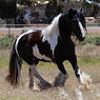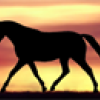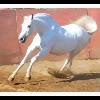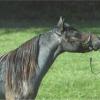Sooty and Dun (New pics pg 2!) :D
Forums
Re: Sooty and Dun
Here are the pictures...
I just can't seem to capture Montana's darkness in pictures... lol Looking at these, it really does just look like his primitive markings becoming more defined..
So my question now, I guess is... he is 6. How long do horses tend to "develop" their markings?
[img]http://i53.tinypic.com/nq4qkk.jpg[/img]
[img]http://i54.tinypic.com/213nss3.jpg[/img]
[img]http://i53.tinypic.com/166xkr8.jpg[/img]
[img]http://i56.tinypic.com/zo9ufl.jpg[/img]
[img]http://i52.tinypic.com/o6i2wp.jpg[/img]
This is Montana's brother. He is very creamy and has been since she got him.
[img]http://i947.photobucket.com/albums/ad31…]
Gotta run real quick, will post Steel and the rest shortly.
Re: Sooty and Dun
Ugh, hate tinypic making those pics so big... but photobucket HATES Crystal's computer.
Here is an older picture of Montana:
[img]http://i51.tinypic.com/2r2btdf.jpg[/img]
And here is Steel. Looking at it now... Steel is looking way more "sooty" than Montana.
[img]http://i53.tinypic.com/wmdugl.jpg[/img]
[img]http://i51.tinypic.com/14iehqc.jpg[/img]
What color do you see Steel being closest to when he gets older? He is completely different from his sister.
[img]http://i52.tinypic.com/fmqpdy.jpg[/img]
For comparison's sake... could you post pictures of the closest colors you can find as to what you think they'll look like all grown up?
Thanks guys. :)
Re: Sooty and Dun
ACC, yes! That is the colt who had cleft palate surgery and I posted foal pictures of back in January!
Re: Sooty and Dun
He has never displayed this "look" until just recently. His face has always been one color. And his color has always been a moussey color until just recently.. His top half is always a "shade" darker during the summer months but that is the only weird look to him we arre trying to figure out. I can't get online aside from on my phone but if you go back a couple months to the thread about Steel's surgery, you can see his parents and foal pictures. His name is AMD James McSteel.
Re: Sooty and Dun
Here is Steel's sire:
http://amdeanranch.com/ourstallions.html" onclick="window.open(this.href);return false;
And the first mare listed here is his dam:
http://amdeanranch.com/salebarnlinks.ht…" onclick="window.open(this.href);return false;
As a foal:
[img]http://sphotos.ak.fbcdn.net/hphotos-ak-…]
[img]http://sphotos.ak.fbcdn.net/hphotos-ak-…]
[img]http://sphotos.ak.fbcdn.net/hphotos-ak-…]
[img]http://sphotos.ak.fbcdn.net/hphotos-ak-…]
[img]http://sphotos.ak.fbcdn.net/hphotos-ak-…]
[img]http://sphotos.ak.fbcdn.net/hphotos-ak-…]
[img]http://sphotos.ak.fbcdn.net/hphotos-ak-…]
[img]http://sphotos.ak.fbcdn.net/hphotos-ak-…]
Re: Sooty and Dun
I took photos a week ago or so of Montana and his half brother, Cowboy. :) Figured I'd share!
Montana
[img]http://fc01.deviantart.net/fs71/f/2010/…]
[img]http://fc08.deviantart.net/fs70/f/2010/…]
Cowboy
[img]http://fc08.deviantart.net/fs70/i/2010/…]
[img]http://fc01.deviantart.net/fs71/i/2010/…]
The rest can be seen here: http://s666.photobucket.com/albums/vv28…" onclick="window.open(this.href);return false;
The guest password, if it asks, is "hoodsey1" :) Enjoy!
Re: Sooty and Dun (New pics pg 2!) :D
Sorry, your gonna have to break it down further for me LOL I'm trying to understand, but I find myself actually argueing in my head, and then I just get dizzy from going in circles?
The way I looked at it, dun, sooty, and counter shading (same thing I guess), what ever you want to call it, is relatively the same yes? As in they are forms of primitive markings? I guess how I define dun, is the leg bars and dorsal stripe; sooty as an animal that darkens with age/has dark hairs through out the coat that normally would not be there; and counter shading as false duns.
But then what throws it all for a loop is, we're having oriental, iberian, and new world breeds pop up with the same pattern, but test for something different? Or thats how I under stand it. For example, a Dun QH, isn't the same as a Dun Lusitano, or a Dun Arabian.
I don't understand how you tell the difference between sooty, and growing dun factor. Because aren't you going to find sooty in the same areas that dun counter shading would effect?
Re: Sooty and Dun (New pics pg 2!) :D
Even sooty horses don't always have darker hairs over their rib cages though. In many of the extreme sooty horses with full body expression, happen to have the lightest areas be their barrels. There are sooty bays where the darker shading is noticeable across the entire top line (not melding with their black points), however there are a number of sooty bays which sooty appears to come up their body instead of down, and you find horses with entire black legs, hips and shoulders. The later is very similar to what you call growing dun factor. Same goes for the neck. All you need to do is google search sooty horse, and you'd see a number of sooty horses who all have markings in the same places you'd have dun factoring. There are sooty and dun horses which have face masks, minimal and expanded.
Re: Sooty and Dun (New pics pg 2!) :D
You're never going to convince me that sooty and dun are the same. There's no way. Even if that's not what you're trying to say, I absolutely don't believe that sooty only goes where dun happens to also go. I also don't believe i have ever seen typical sooty markings on a dun.
I've never seen a dun carrying horse have anything like this:
http://colormorgans.tripod.com/vimyridg…" onclick="window.open(this.href);return false;
I've never seen a dun with this:
http://www.theequinest.com/images/smutt…" onclick="window.open(this.href);return false;
Or this:
http://www.theequinest.com/images/black…" onclick="window.open(this.href);return false;
The horse Swinghorse showed us has dark shading in all of the areas that are described as dun, not random areas of darkness. Every place he has developed this shading is in a place that one expects to see dun.
Re: Sooty and Dun (New pics pg 2!) :D
I'm not saying that they are the same. I feel that what people call dun, sooty, and counter shading (false duns) are similar because they all contribute primitive markings. All three of these seem to have their own categories, and all have horses which break the 'ideals' for said categories.
What I did, was ask you to explain this theory. I've run into more then one person that has recited what you said, but could not give me any more info on the subject, so I figured I'd go to the source. But if you're response to me is that you do not know, and you only came to this conclusion because you've never seen one before, well I guess I just have to take you're word for it.
The problem I find there, is that since all sooty horses do not have a set of rules they follow - other then the fact they add darker hairs to parts of the body that [i]typically[/i] reflect the most light - what would you use to be able to tell the difference between a dun with sooty, and a dun without.
There are horses which both dun, and sooty become more expressed with age.
And there are horses who's sooty body points are located the same areas you see dun. But not all horses continue to darken.
And we know that dun dilutes the body of the horse, and I don't think it's just pure chance that in (normal) duns, the barrel is always the lightest point on the body. So you may be onto something in regards to dun suppressing the expression of darker color, if your only observation is that dun horses do not have dark hairs on their rib cages, where as sooty horses do. However in saying that, that would be saying that all sooty horses have dark hairs over their ribs, which would be untrue.
There also may be some relevance if the base color of dun horses is taken into consideration. I find that Grulla horses tend to appear more sooty/mottled then those of Bay or Red duns, and Bays being more mottled then those of Red duns. However there are those red duns that prove those statements untrue, with horses like [url=http://www.mcbridesquarterhorses.com/db… Jack Whiz[/url] and [url=http://www.infoalpartners.com/Einstein… Resolve[/url], who both darkened incredibly as they aged. And when you throw cream into the mix, it's a whole nother story.
[url=http://image04.webshots.com/4/4/7/52/73… Palomino, with concentrated mask on head[/url]
[url=http://www.centralasianequines.com/hors… Akhal teke with concentrated Shoulder mottling[/url]
(on that breeders website, Dushka, Gozakhal, and Guana all have sooty counter shading where dun horses also have mottling - stifle, shoulder, neck)
And of course [url=http://www.fossilgatefarms.com/mryellaf…. Yellow Fellow[/url], who by now looks like those Red Duns above.
I know the images I posted are of non dun horses. And I could post a number of images of Dun horses that share similar patterns. Specially those that are either so minimally diluted, or so highly mottled that you can't make out any leg baring. But since sooty also shows a mottling pattern on horses legs. Are we seeing sooty, mottling, or lack of dilution?
And if all these classes of modifiers - dun factor, sooty, and counter shading - can all result in a false dun horse. I'd said it's more fair to see them as closely related, then so dissimilar.
Re: Sooty and Dun (New pics pg 2!) :D
I can't. I have no proof besides what I have witnessed with my own eyes. I won't say that it is impossible for sooty to show in the areas where the dun factor is showing (in fact I have seen black dorsals on palomino duns and thus I feel they MUST be sooty in that area, and I've said that many times before in several places) however I do not believe that dun will allow sooty to show anywhere else.
I think part of the reason you and I disagree is that you seem to believe a liver chestnut is a sooty chestnut and I do not believe that.
I've seen A LOAD of sooty horses. I'm pretty familiar with how it appears. I've still yet to see a horse who showed sooty and dun together (unless you want to include the black dorsal on a palomino dun, etc.).
Re: Sooty and Dun (New pics pg 2!) :D
Eh. I do not know what to think of Liver chestnuts and sooty chestnuts. I do think that some breeds have bred for the darker shades of chestnut intentionally, and thus over a periode of time have a uniform dark chestnut coat. I've always thought liver chestnuts were more uniform in color, when compared to a sooty chestnut.
In sooty foals I've bred, I know they darken with age. And while I've seen some really black liver chestnuts, I do not know if they are born normal and then darken, because I've never bred one.
Re: Sooty and Dun (New pics pg 2!) :D
We get a lot of very dark (sooty? brown?) bays in the shetlands here, which then with cream added have very dark buckskins. It's actually very hard to find the bright red, or clean tan buckskins. But when these dark bay ponies ponies are put to duns, you never get dark duns. They are normal bright clean yellow/bay duns. Various shades of course, but they never have the sooty overtones that their non dun parents did. So I always thought, long before I had heard the theory, that was what dun did. Took away the sooty. So I don't know what it really does, but it certainly cleans up the colour in the bay base ones!




Re: Sooty and Dun
Dunno, I always though dun mostly took sooty away except for where the primitive markings were. So I'd assume as the sooty is coming in more, the dun markings are getting more obvious?!
I'd be interesting is seeing the pictures!